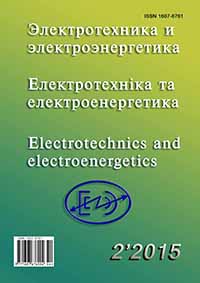GEOMETRIC INTERPRETATION OF REACTIVE POWER AND ITS RELATION WITH THE SPECTRAL COMPOSITION OF THE TRACTION VOLTAGE AND CURRENT OF HIGH-SPEED LOCOMOTIVES
DOI:
https://doi.org/10.15588/1607-6761-2015-2-11Keywords:
two-terminal, reactive power, non-sinusoidal value, electric, electric locomotive, spectral composition, current-voltage characteristics, harmonicaAbstract
The introduction in Ukraine of high-speed trains with increased of their traffic up to 200 km/h requires the more powerful than the normal movement of types of alternating current electric rolling stock, in particular, electric locomotives. It is known that the more powerful electric locomotives are the more powerful generators of reactive power, in which the transit system of AC electric traction is one of the problems that are still not resolved. Therefore the design of new special stages or the transition of the existing ones from the DC system to AC should be done taken into account the generation and transit in system of the electric drive train of the reactive power. Even to this day there is a problem in electrical engineering of reactive power estimation and energy performance of the non-linear, or even the more unsteady, consumers. Therefore, preference is given to the theory, which, firstly, reflects the maximum information about the energy process and, secondly, allows to operate with the instant system characteristics. The paper found that there is some connection between CVC and spectral composition circles with non-sinusoidal voltage and current in the two-terminal circuit. According to the research the numerical analysis of the specified connection is performed for high-speed electric locomotive DS 3MReferences
Курбасов А. С. Система электрической тяги XXI века / А. С. Курбасов// Железные дороги мира. – 1999. – №4. – С. 19–22
Аржанников Б. А. Перспектива разработки системы электрической тяги постоянного тока повышенного напряжения 24 кВ для скоростной магистрали Москва-Екатеринбург / Б. А. Аржанников, // Тренды. События. Рынки. – 2012. – №7. – С. 48–50
О переходе с постоянного тока на переменный // Железные дороги мира. – 2013. – №6. – С. 68–71
Міщенко Т. М. Перспективи схемотехнічних рішень і моделювання підсистем електричної тяги при високошвидкісному русі поїздів. / Т.М. Міщенко // Електротехніка та Електроенергетика. – 2014. – № 1. – С. 19–28.
Демирчян К. С. Реактивная или обменная мощность / К. С. Демирчян // Изв. АН СССР. Энергетика и транспорт. – 1984. – №2. – С. 66–72
Жарков Ф. П. Об одном способе определения реактивной мощности / Ф. П. Жарков // Изв. АН СССР. Энергетика и транспорт. – 1984. – №2. – С. 73–81
Жежеленко И. В. Реактивная мощность в задачах электроэнергетики / И. В. Жежеленко, Ю. Л. Саенко // Электричество. – 1987. – №2. – С. 7–12
Демирчян К. С. Реактивная мощность на случай несинусоидальных функций / К. С. Демирчян // Изв. РАН Энергетика. – 1992. – №1. – С. 3–18
Тонкаль В. Е. Баланс энергии в электрических цепях / В. Е. Тонкаль, В. А. Новосельцев, С. П. Денисюк “К. : Наук. думка, 1992. – 312 с.
Демирчян К. С. Разложение мгновенной мощность на составляющие / К. С. Демирчян // Изв. РАН Энергетика. – 1994. – №5. – С. 73–79
Саенко Ю. Л. Реактивная мощность в системах электроснабжения с нелинейными нагрузками: дис. …доктора техн. наук: 05.09.05 / Саенко Юрий Леонидович. – Мариуполь, «Приазов. Гос. тех. университет», 2002. – 349 с.
Маевский О. А. Энергетические показатели вентильных преобразователей / О. А. Маевский. – М. : Энергия, 1978. – 320 с.
Маевский О. А. Методы определения реактивной мощносты нелинейных электрических цепей с помощью их циклических вольт-амперных характеристик [Текст] / О. А. Маевский // Харьков: Bестник ХПИ. №45(93) Преобразовательная техника, 1970. – Вып.4. – С. 9–17.
Downloads
How to Cite
Issue
Section
License
Copyright (c) 2017 T. M. Mishchenko

This work is licensed under a Creative Commons Attribution 4.0 International License.
Creative Commons Licensing Notifications in the Copyright Notices
Authors who publish with this journal agree to the following terms:
Authors retain copyright and grant the journal right of first publication with the work simultaneously licensed under aCreative Commons Attribution License that allows others to share the work with an acknowledgement of the work's authorship and initial publication in this journal.
Authors are able to enter into separate, additional contractual arrangements for the non-exclusive distribution of the journal's published version of the work (e.g., post it to an institutional repository or publish it in a book), with an acknowledgement of its initial publication in this journal.
Authors are permitted and encouraged to post their work online (e.g., in institutional repositories or on their website) prior to and during the submission process, as it can lead to productive exchanges, as well as earlier and greater citation of published work.

